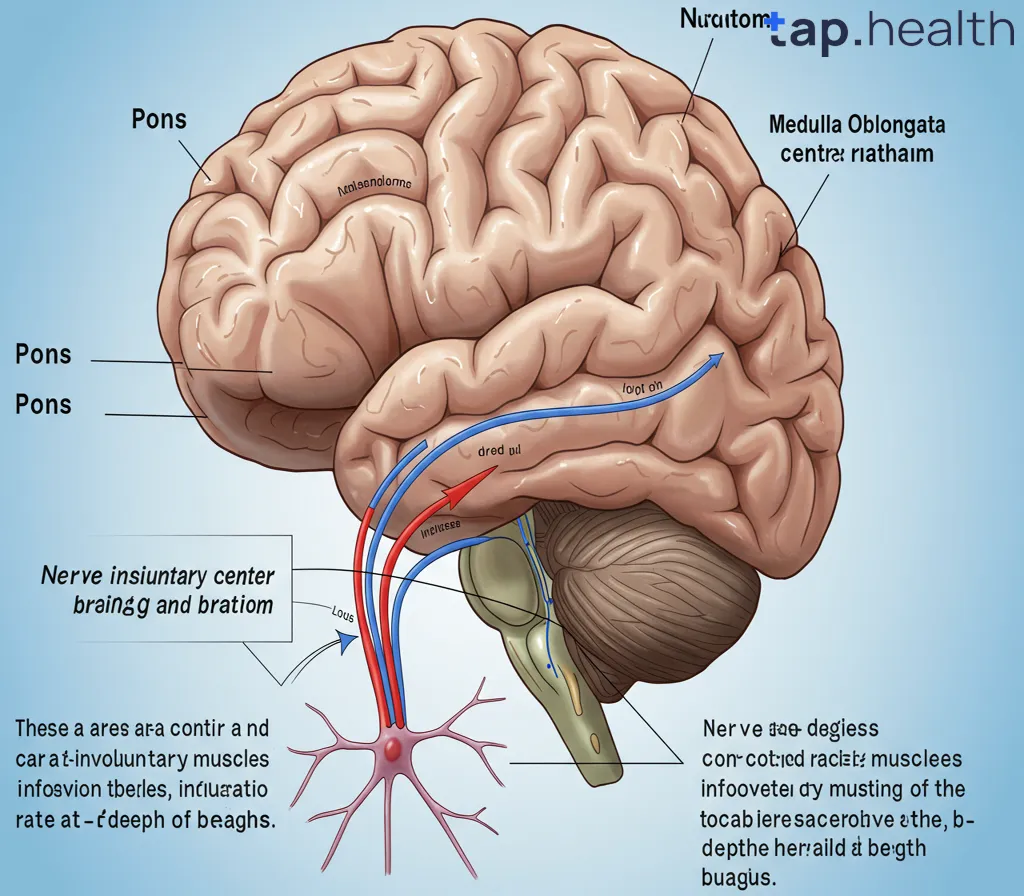Respiration is the process through which our bodies take in oxygen and expel carbon dioxide. This process is essential for all life forms as oxygen fuels the body’s cells, while carbon dioxide is a waste product that must be removed.
While we may think of breathing as a voluntary action (like taking a deep breath or holding your breath), much of it occurs automatically. The brain plays a crucial role in controlling respiration, ensuring that we breathe appropriately to meet the body’s needs. Let’s explore how this happens.
The Brain Structures That Control Breathing
There are several key areas of the brain responsible for controlling our breathing. These regions work in harmony to ensure that our breathing rate is adjusted according to the body’s oxygen needs.
Medulla Oblongata: The Heart of Respiration
The medulla oblongata, located in the brainstem, is the primary control center for respiration. This structure is responsible for initiating the basic rhythm of breathing. The medulla receives signals from various parts of the body about the levels of oxygen and carbon dioxide in the blood. Based on this information, it adjusts the breathing rate to maintain homeostasis.
The medulla contains the respiratory centers, which are divided into two main groups:
- Dorsal Respiratory Group (DRG): This controls the basic rhythm of inhalation.
- Ventral Respiratory Group (VRG): This controls both inhalation and exhalation, particularly during times of increased demand, such as during exercise.
The medulla oblongata is responsible for automatic breathing. Even if you stop consciously thinking about it, your body will continue to breathe thanks to the signals sent from this region of the brain.
Pons: Fine-Tuning the Breathing Rhythm
The pons is another part of the brainstem that plays a role in regulating breathing. It works in conjunction with the medulla oblongata to smooth the transitions between inhalation and exhalation.
The pneumotaxic center and apneustic center in the pons help fine-tune the breathing process. The pneumotaxic center limits the duration of inhalation, while the apneustic center promotes deeper inhalation.
Together, these centers help adjust the breathing pattern during activities that require more energy, such as exercise, and also help with normal resting breathing.
Cortex: Voluntary Control of Breathing
While the medulla and pons regulate involuntary breathing, the cortex is responsible for the voluntary control of respiration. This means that you can consciously alter your breathing rate, such as when you hold your breath or take slow, deep breaths to relax.
The cortex allows you to override the automatic rhythms of breathing temporarily. For example, when you consciously decide to take a deep breath, you are using the motor cortex of the brain to initiate the action. However, even after you stop thinking about it, the medulla takes back control, and your breathing returns to normal.
How the Brain Regulates Breathing
The brain controls breathing through a combination of feedback from sensors in the body and automatic responses to changes in the environment. Let’s take a closer look at the mechanisms that regulate breathing.
Chemoreceptors: Sensors of Oxygen and Carbon Dioxide
Chemoreceptors are special sensors located in the brain and throughout the body. They are sensitive to the levels of oxygen (O₂) and carbon dioxide (CO₂) in the blood.
There are two primary types of chemoreceptors:
- Central Chemoreceptors: Located in the medulla, these receptors detect changes in CO₂ levels in the cerebrospinal fluid (CSF). High levels of CO₂ signal the brain to increase the rate and depth of breathing.
- Peripheral Chemoreceptors: Found in the carotid arteries and aorta, these receptors are more sensitive to low O₂ levels in the blood. When oxygen levels drop, these chemoreceptors signal the brain to adjust breathing to increase oxygen intake.
Feedback Loops: Maintaining Balance
Feedback loops are essential for maintaining the right balance of gases in the body. If the levels of oxygen or carbon dioxide become too high or low, the brain automatically adjusts the breathing rate. For example:
- Increased CO₂: When CO₂ levels rise, the blood becomes more acidic (lower pH), which signals the medulla to increase the rate of breathing, helping to expel CO₂ more quickly.
- Decreased O₂: Low oxygen levels trigger the peripheral chemoreceptors, prompting the brain to increase the breathing rate to take in more oxygen.
These feedback mechanisms ensure that we always have the right balance of oxygen and carbon dioxide in our bodies, which is crucial for survival.
Common Disorders Affecting Respiratory Control
While the brain does a remarkable job of regulating breathing, certain disorders can disrupt this process. Let’s explore a few conditions that can affect respiratory control.
Sleep Apnea
Sleep apnea is a common condition in which breathing repeatedly stops and starts during sleep. The condition occurs when the brain fails to send proper signals to the respiratory muscles, causing temporary pauses in breathing. This can result in lower oxygen levels during sleep, leading to a range of health problems, including fatigue, cardiovascular issues, and high blood pressure.
Central Respiratory Depression
Central respiratory depression is a condition in which the brain’s respiratory centers become less responsive to changes in CO₂ and O₂ levels. This can result from drug overdoses, brain injury, or other neurological conditions. When the brain is unable to regulate breathing properly, it can lead to slow, shallow, or irregular breathing, which can be life-threatening if left untreated.
Why is the Brain’s Role in Respiration Important?
The brain’s ability to control respiration is essential for maintaining life. Without this regulation, the body wouldn’t be able to respond to changes in oxygen and carbon dioxide levels, leading to a breakdown of cellular functions.
Additionally, the brain’s control over voluntary breathing allows us to adapt our breathing to various situations, such as during physical activity or while speaking. Without this ability, we would be unable to perform many basic tasks, such as exercising or even talking.
Frequently Asked Questions on Which Part of the Brain Controls Respiration?
Can the brain control breathing during sleep?
Yes, the brain continues to regulate breathing during sleep. The medulla oblongata and pons control involuntary breathing, ensuring that the body continues to breathe even when we are unconscious.
What happens if the brain’s respiratory centers are damaged?
Damage to the brain’s respiratory centers can lead to difficulty regulating breathing. This could result in shallow breathing, irregular breathing patterns, or even respiratory failure, depending on the extent of the damage.
Why is breathing so automatic?
Breathing is automatic because it is controlled by the brainstem, specifically the medulla oblongata and pons. These areas of the brain handle breathing without conscious thought, allowing the body to function without us needing to focus on every breath we take.
How does the brain respond to changes in oxygen levels?
The brain uses chemoreceptors to detect changes in oxygen levels. When oxygen levels fall, the brain signals the respiratory muscles to increase the breathing rate, ensuring that more oxygen is taken in to restore balance.
In conclusion, respiration is one of the many vital functions controlled by the brain. Through intricate feedback mechanisms and the coordination of different brain structures, such as the medulla oblongata, pons, and cortex, the brain ensures that we breathe properly, even when we are not consciously aware of it.



